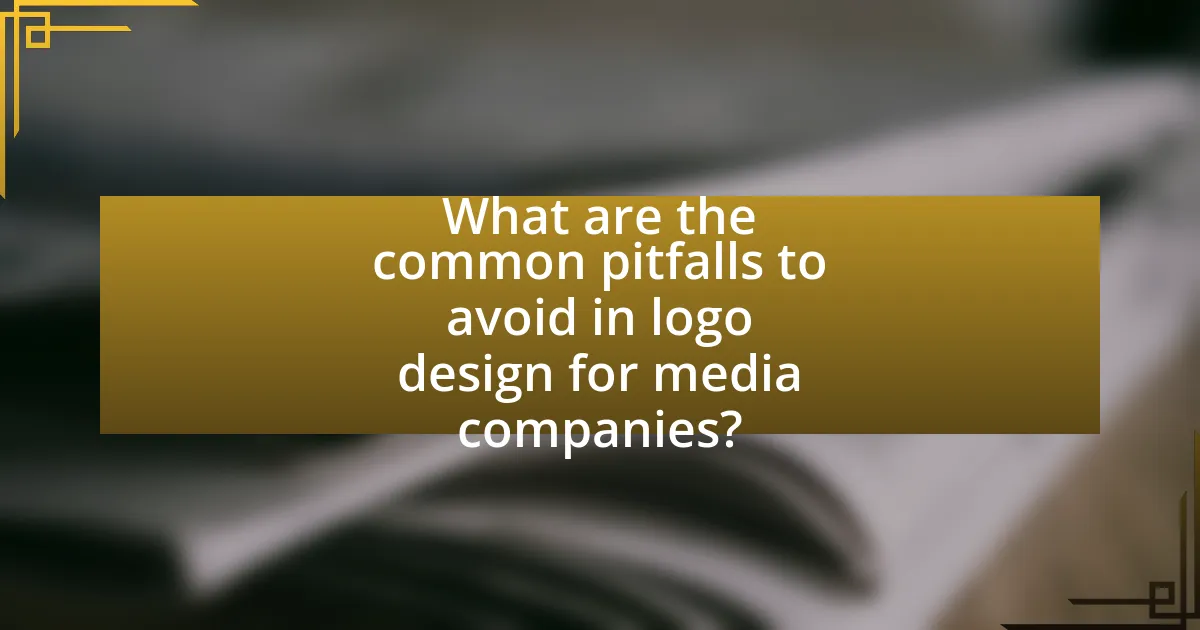The article focuses on the essential practices for creating a memorable logo specifically for media companies. It outlines key elements such as simplicity, relevance, versatility, and uniqueness, emphasizing their importance in logo design. The impact of color choice and typography on brand perception and memorability is also discussed, along with best practices for selecting fonts and utilizing color palettes effectively. Additionally, the article highlights common pitfalls to avoid, the significance of understanding the target audience, and methods for testing logo effectiveness, providing a comprehensive guide for media companies aiming to enhance their brand identity through effective logo design.

What are the key elements of creating a memorable logo for media companies?
The key elements of creating a memorable logo for media companies include simplicity, relevance, versatility, and uniqueness. Simplicity ensures that the logo is easily recognizable and memorable, as complex designs can confuse viewers. Relevance connects the logo to the media company’s brand identity and values, making it meaningful to the target audience. Versatility allows the logo to be effective across various platforms and sizes, from digital to print, ensuring consistent branding. Uniqueness differentiates the logo from competitors, making it stand out in a crowded market. For instance, a study by the University of Massachusetts found that logos with simple designs are more likely to be remembered by consumers, reinforcing the importance of simplicity in logo design.
How does color choice impact logo memorability?
Color choice significantly impacts logo memorability by influencing emotional responses and recognition. Research indicates that colors can evoke specific feelings and associations, which helps consumers remember brands more effectively. For instance, a study published in the Journal of Business Research found that color increases brand recognition by up to 80%. Additionally, colors can create a visual identity that distinguishes a logo from competitors, enhancing recall. For example, red often conveys excitement and urgency, while blue is associated with trust and reliability, shaping how consumers perceive and remember a brand.
What psychological effects do colors have on audience perception?
Colors significantly influence audience perception by evoking specific emotions and associations. For instance, blue often conveys trust and reliability, making it a popular choice for corporate branding, while red can evoke excitement and urgency, frequently used in sales promotions. Research by the Institute for Color Research indicates that color increases brand recognition by up to 80%, demonstrating its critical role in shaping consumer attitudes. Additionally, a study published in the Journal of Experimental Psychology found that colors can affect decision-making processes, with warm colors prompting quicker responses compared to cooler tones. Thus, the psychological effects of colors are essential for media companies aiming to create impactful logos that resonate with their target audience.
How can color palettes be effectively used in logo design?
Color palettes can be effectively used in logo design by selecting colors that evoke specific emotions and align with brand identity. For instance, blue often conveys trust and professionalism, making it suitable for media companies aiming to establish credibility. Research indicates that color can increase brand recognition by up to 80%, highlighting its importance in logo design. Additionally, using a limited color palette ensures simplicity and versatility, allowing the logo to be easily recognizable across various platforms and sizes. This strategic approach to color selection not only enhances visual appeal but also reinforces the brand’s message and values.
What role does typography play in logo design?
Typography plays a crucial role in logo design by conveying brand identity and enhancing visual communication. The choice of typeface influences how a brand is perceived; for instance, serif fonts often evoke tradition and reliability, while sans-serif fonts suggest modernity and simplicity. Research indicates that 90% of visual information transmitted to the brain is related to typography, underscoring its importance in creating memorable logos. Effective typography not only ensures readability but also establishes a unique character for the brand, making it easily recognizable and memorable to the audience.
How do different font styles convey brand personality?
Different font styles convey brand personality by evoking specific emotions and associations that align with a brand’s identity. For instance, serif fonts often communicate tradition and reliability, making them suitable for established brands like financial institutions, while sans-serif fonts project modernity and simplicity, appealing to tech companies. Script fonts can convey elegance and creativity, often used by luxury brands or artistic ventures. Research indicates that font choice can significantly influence consumer perception; a study published in the Journal of Marketing Research found that consumers associate certain font styles with specific personality traits, reinforcing the idea that typography is a critical element in brand communication.
What are the best practices for selecting fonts for logos?
The best practices for selecting fonts for logos include ensuring legibility, reflecting brand identity, and maintaining versatility. Legibility is crucial, as a logo must be easily readable at various sizes and on different backgrounds; for instance, sans-serif fonts often enhance clarity. Reflecting brand identity involves choosing a font that aligns with the company’s values and target audience; for example, a tech company may opt for modern, sleek fonts, while a children’s brand might choose playful, rounded typefaces. Versatility is important as the font should work across multiple platforms and mediums, ensuring consistency in branding. Research indicates that 95% of consumers consider visual appearance as a key factor in their purchasing decisions, underscoring the importance of thoughtful font selection in logo design.
Why is simplicity important in logo design?
Simplicity is important in logo design because it enhances recognition and memorability. A simple logo allows for quick identification, making it easier for consumers to recall the brand. Research indicates that logos with fewer elements are more effective; for instance, a study by the University of Massachusetts found that simple logos are 13% more likely to be remembered than complex ones. This principle is evident in successful brands like Nike and Apple, whose minimalist logos contribute to their strong brand identities.
How does a simple logo enhance brand recognition?
A simple logo enhances brand recognition by making it easily identifiable and memorable. Research indicates that logos with minimal design elements are more effective in capturing consumer attention and fostering brand recall. For instance, a study published in the Journal of Marketing Research found that simple logos are processed faster by the brain, leading to quicker recognition and stronger associations with the brand. This efficiency in cognitive processing allows consumers to remember and differentiate brands more effectively, ultimately contributing to increased loyalty and preference.
What are examples of successful simple logos in the media industry?
Successful simple logos in the media industry include the logos of BBC, CNN, and NBC. The BBC logo features a straightforward design with bold, black letters on a white background, making it easily recognizable and memorable. CNN’s logo utilizes a simple red and white color scheme with a distinctive font that conveys immediacy and clarity, reflecting its news focus. NBC’s peacock logo, while slightly more complex, maintains simplicity through its clean lines and vibrant colors, symbolizing diversity and entertainment. These logos demonstrate effectiveness through their clarity, memorability, and ability to convey the brand’s identity succinctly.

How can media companies ensure their logos stand out?
Media companies can ensure their logos stand out by utilizing unique design elements, such as distinctive shapes, bold colors, and innovative typography. Unique design elements help create visual differentiation in a crowded market, making logos more memorable. For instance, a study by the University of Toronto found that logos with simple, yet unique designs are 13% more likely to be remembered by consumers compared to complex logos. Additionally, incorporating relevant symbolism that reflects the company’s values or mission can enhance recognition and emotional connection with the audience.
What unique design techniques can be employed?
Unique design techniques that can be employed in creating memorable logos for media companies include the use of negative space, geometric shapes, and custom typography. Negative space allows designers to create dual imagery, enhancing visual interest and memorability; for example, the FedEx logo cleverly uses negative space to form an arrow between the letters. Geometric shapes provide a modern and clean aesthetic, which can convey professionalism and clarity, as seen in the logos of tech companies like IBM. Custom typography enables brands to establish a unique identity, as demonstrated by the distinct typefaces used by brands like Coca-Cola, which contribute to brand recognition. These techniques are effective because they not only capture attention but also communicate brand values succinctly.
How can negative space be utilized in logo design?
Negative space can be utilized in logo design to create visual interest and convey hidden meanings. By strategically using the space around and between elements, designers can form shapes or symbols that enhance the overall message of the logo. For instance, the FedEx logo employs negative space to create an arrow between the letters “E” and “x,” symbolizing speed and precision. This technique not only makes the logo more memorable but also engages viewers by inviting them to discover the hidden elements, thereby reinforcing brand identity.
What are the benefits of incorporating symbolism in logos?
Incorporating symbolism in logos enhances brand recognition and conveys deeper meanings. Symbolism allows logos to communicate values, mission, and identity succinctly, making them more memorable to consumers. For instance, the use of a tree in a logo can symbolize growth and sustainability, aligning the brand with eco-friendly practices. Research indicates that logos with symbolic elements can increase consumer engagement by up to 30%, as they resonate emotionally and create a lasting impression. This emotional connection fosters brand loyalty, as consumers are more likely to remember and prefer brands that reflect their values through symbolism.
How does understanding the target audience influence logo design?
Understanding the target audience significantly influences logo design by ensuring that the visual identity resonates with the intended demographic. When designers comprehend the preferences, values, and cultural context of their audience, they can create logos that evoke the desired emotional response and establish brand recognition. For instance, a study by the American Marketing Association found that logos aligned with consumer expectations can enhance brand loyalty by up to 30%. This demonstrates that a well-informed approach to audience understanding directly impacts the effectiveness of logo design in achieving marketing goals.
What demographic factors should be considered in logo creation?
In logo creation, key demographic factors include age, gender, cultural background, and socioeconomic status. These factors influence design elements such as color, typography, and imagery, which must resonate with the target audience. For instance, research indicates that younger audiences may prefer vibrant colors and modern fonts, while older demographics might favor classic designs and muted tones. Additionally, cultural backgrounds can dictate symbolism and color meanings, making it essential to understand the audience’s cultural context to avoid misinterpretation. Socioeconomic status can also affect preferences; luxury brands often use minimalist designs to convey exclusivity, while budget-friendly brands may opt for more approachable aesthetics. Understanding these demographic factors ensures that the logo effectively communicates the brand’s message and appeals to its intended audience.
How can audience feedback shape logo design decisions?
Audience feedback can significantly shape logo design decisions by providing insights into how the target demographic perceives and connects with the design elements. This feedback allows designers to understand preferences regarding colors, shapes, and overall aesthetics, ensuring that the logo resonates with the intended audience. For instance, a study by the American Marketing Association found that logos that align with consumer expectations can enhance brand recognition by up to 80%. By incorporating audience feedback, designers can refine their concepts to better reflect the values and emotions that the audience associates with the brand, ultimately leading to a more effective and memorable logo.

What are the common pitfalls to avoid in logo design for media companies?
Common pitfalls to avoid in logo design for media companies include overcomplicating the design, neglecting scalability, and failing to consider brand identity. Overcomplicating the design can lead to a logo that is difficult to recognize and remember; research shows that simple logos are more effective in brand recall. Neglecting scalability can result in a logo that loses clarity when resized, which is crucial for various media formats. Additionally, failing to align the logo with the brand identity can confuse the audience, as a logo should reflect the company’s values and mission. These pitfalls can undermine the effectiveness of a logo in representing a media company.
What mistakes do companies often make when designing logos?
Companies often make the mistake of prioritizing trends over timelessness when designing logos. This approach can lead to logos that quickly become outdated, failing to establish a lasting brand identity. For instance, a study by the American Institute of Graphic Arts found that logos designed with a focus on current design trends often lose relevance within a few years, necessitating costly redesigns. Additionally, companies frequently overlook the importance of scalability, resulting in logos that do not perform well across various mediums, from business cards to billboards. This lack of versatility can hinder brand recognition and visibility.
How can overcomplication detract from logo effectiveness?
Overcomplication can detract from logo effectiveness by making the design difficult to recognize and remember. A logo that is overly intricate can confuse viewers, leading to a lack of brand recall. Research indicates that simple logos are more easily processed and retained in memory; for instance, a study published in the Journal of Consumer Research found that simpler logos are associated with higher brand recognition and preference. Therefore, a straightforward design enhances clarity and impact, while complexity can hinder communication and brand identity.
What are the risks of following design trends too closely?
Following design trends too closely can lead to a lack of originality and brand identity dilution. When companies prioritize current trends over their unique values and vision, they risk blending in with competitors, making it difficult for consumers to distinguish their brand. For instance, a study by the Design Management Institute found that brands with a strong design identity outperform their competitors by 228% over ten years. This indicates that adherence to fleeting trends can undermine long-term brand equity and recognition. Additionally, trends often have a short lifespan; what is popular today may be outdated tomorrow, leading to frequent redesigns that can confuse customers and erode trust.
How can companies test the effectiveness of their logos?
Companies can test the effectiveness of their logos through methods such as consumer surveys, A/B testing, and brand recognition studies. Consumer surveys allow companies to gather direct feedback on logo appeal and memorability from target audiences, providing quantitative data on preferences. A/B testing involves presenting different logo designs to segments of the audience to analyze which version generates higher engagement or conversion rates. Brand recognition studies assess how well consumers can identify a brand based on its logo, often measuring recall and recognition against competitors. These methods are supported by research indicating that logos significantly impact brand perception and consumer behavior, with studies showing that well-designed logos can increase brand loyalty and recognition by up to 80%.
What methods can be used to gather feedback on logo designs?
Surveys and focus groups are effective methods to gather feedback on logo designs. Surveys allow for quantitative data collection from a larger audience, enabling designers to assess preferences and perceptions regarding various logo options. Focus groups provide qualitative insights through in-depth discussions, allowing participants to express their thoughts and feelings about the designs. Research indicates that using a combination of these methods can yield comprehensive feedback, as surveys can quantify trends while focus groups can explore the reasoning behind those trends.
How can A/B testing improve logo design outcomes?
A/B testing can improve logo design outcomes by allowing designers to compare two or more logo variations to determine which one resonates better with the target audience. This method provides quantitative data on user preferences, enabling informed decisions based on actual consumer behavior rather than assumptions. For instance, a study by Nielsen Norman Group found that A/B testing can increase conversion rates by up to 300% when applied to design elements, including logos. By analyzing metrics such as click-through rates and user engagement, designers can refine logo elements to enhance brand recognition and appeal, ultimately leading to a more effective visual identity for media companies.
What are the best practices for creating a memorable logo for media companies?
The best practices for creating a memorable logo for media companies include simplicity, relevance, versatility, and uniqueness. Simplicity ensures that the logo is easily recognizable and memorable; for instance, logos like those of BBC and CNN are straightforward yet effective. Relevance means the logo should reflect the media company’s identity and values, such as using imagery that conveys communication or information. Versatility is crucial, as the logo must work across various platforms and sizes, from digital to print; a good example is the adaptable design of the National Geographic logo. Lastly, uniqueness helps the logo stand out in a crowded market, which is vital in the competitive media landscape, as seen with the distinct design of the Vice Media logo. These practices collectively enhance brand recognition and recall among audiences.
How can collaboration with professional designers enhance logo quality?
Collaboration with professional designers enhances logo quality by leveraging their expertise in visual communication and branding principles. Professional designers possess a deep understanding of design elements such as color theory, typography, and composition, which are crucial for creating a visually appealing and effective logo. Their experience allows them to craft logos that not only capture the essence of a brand but also resonate with the target audience. Research indicates that well-designed logos can increase brand recognition by up to 80%, demonstrating the significant impact of professional design on logo effectiveness.
What steps should be taken to ensure a logo is versatile across different media platforms?
To ensure a logo is versatile across different media platforms, designers should create it in vector format, allowing for scalability without loss of quality. Vector graphics maintain clarity at any size, making them suitable for various applications, from business cards to billboards. Additionally, designers should limit the color palette to a few key colors, ensuring the logo remains recognizable in both color and monochrome formats. This approach enhances adaptability across different backgrounds and mediums. Furthermore, testing the logo in various sizes and formats, such as digital and print, helps identify any potential issues with visibility or legibility. Research indicates that logos with simple designs are more easily recognized and remembered, reinforcing the importance of simplicity for versatility.

Leave a Reply